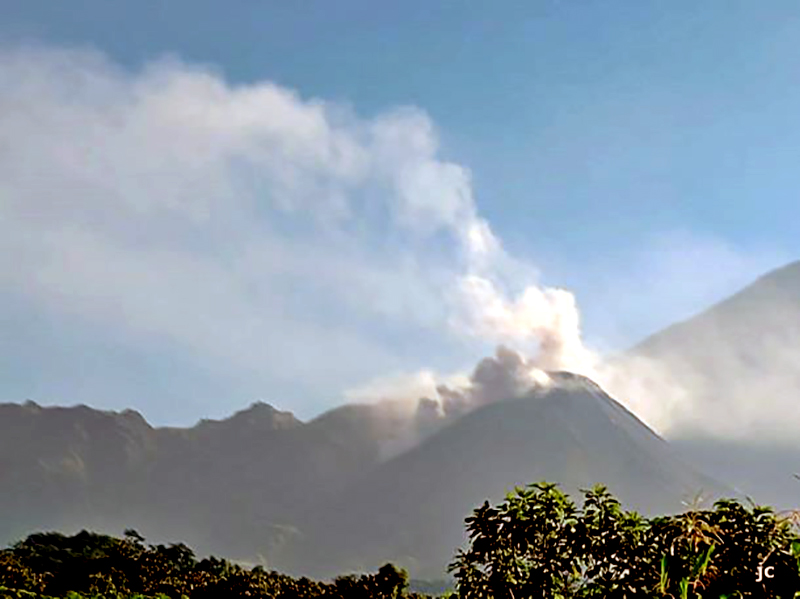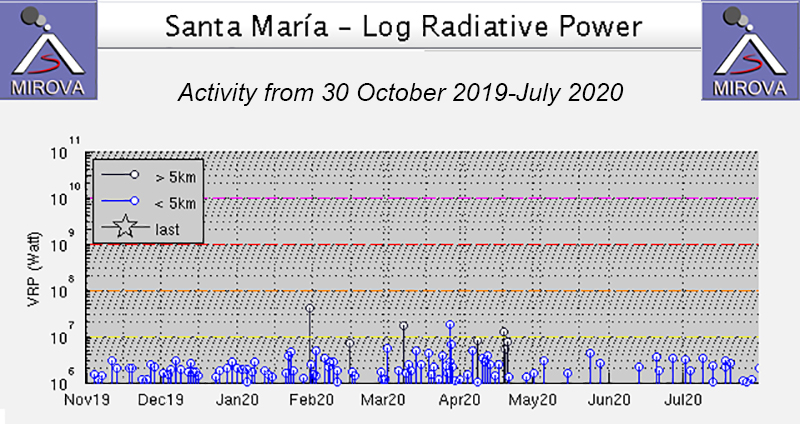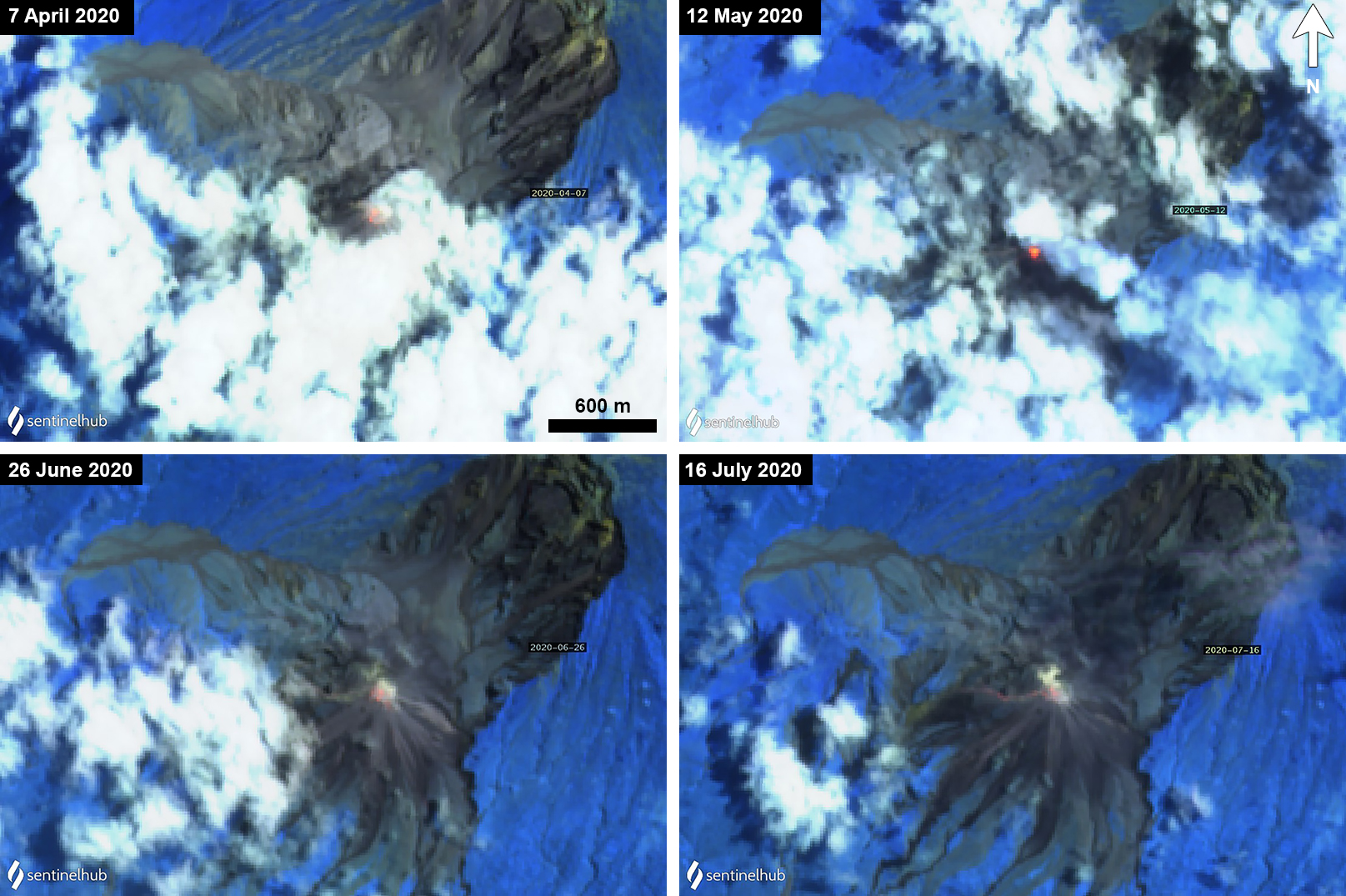Report on Santa Maria (Guatemala) — August 2020
Bulletin of the Global Volcanism Network, vol. 45, no. 8 (August 2020)
Managing Editor: Edward Venzke.
Edited by Kadie L. Bennis.
Santa Maria (Guatemala) Daily explosions with ash plumes, block avalanches, and pyroclastic flows during March-July 2020
Please cite this report as:
Global Volcanism Program, 2020. Report on Santa Maria (Guatemala) (Bennis, K.L., and Venzke, E., eds.). Bulletin of the Global Volcanism Network, 45:8. Smithsonian Institution. https://doi.org/10.5479/si.GVP.BGVN202008-342030
Santa Maria
Guatemala
14.757°N, 91.552°W; summit elev. 3745 m
All times are local (unless otherwise noted)
Santa María is a stratovolcano located in Guatemala, which includes the Santiaguito lava-dome complex on the W flank. The youngest and more recently active of the four vents is the Caliente cone, characterized by explosions, ash plumes, pyroclastic flows, and lahars (BGVN 45:04). A lava dome appeared in the summit crater of Caliente in October 2016 and has continued to grow. The Caliente vent is at about 2.5 km elevation, and the summit of the volcano is around 3.7 km elevation. Daily explosions, ash plumes, ashfall, and block avalanches continued during this reporting period of March-July 2020 with information primarily from INSIVUMEH (Instituto Nacional de Sismologia, Vulcanologia, Meterologia e Hidrologia), the Washington VAAC (Volcanic Ash Advisory Center), and various satellite data.
Constant white gas-and-steam emissions from the Caliente dome reached 2.8-3.4 km altitude throughout March-July 2020. Multiple explosions were registered each day, many of which were accompanied by ash plumes rising to 3-3.7 km altitude and drifting in multiple directions up to 15 km from the Caliente dome. Block avalanches, ash plumes, and a few weak to moderate pyroclastic flows were prominent during this reporting period, according to INSIVUMEH. Intermittent incandescence was also observed in the Caliente dome. Occasional ashfall was observed in nearby communities.
During March, the STG3 seismic station registered weak to moderate explosions that produced ash plumes rising to 3.5 km altitude drifting in multiple directions as far as 1.5 km from the Caliente dome. The explosions also generated weak to moderate block avalanches along the S, E, SE, and SW flanks on the Caliente dome. Occasional incandescence in the Caliente crater was observed at night. Some ashfall was reported in the villages of Loma Linda, San Marcos, and Palajunoj on 5, 8, 13-14, 16, 20, and 28-29 March, and the mountainous areas of Monte Carlo on 30 March.
Explosions continued in April (figure 108), producing ash plumes up to 3.5 km altitude drifting in multiple directions as far as 1.2 km. Constant block avalanches were reported on the S, E, SE, and SW flanks of the Caliente dome, occasionally accompanied by incandescence. Intermittent ashfall was reported in the villages of Loma Linda and San Marcos during the month, including fine ashfall on the volcanic perimeter. On 21 April weak explosions produced an ash plume rising 3.4 km altitude drifting W and SW, resulting in ashfall in Loma Linda and San Marcos and block avalanches on the S, E, and SE flanks (figure 109). On 24 April fine ashfall was also reported in Finca La Florida (5 km S) and Santa Marta (5-6 km SW).
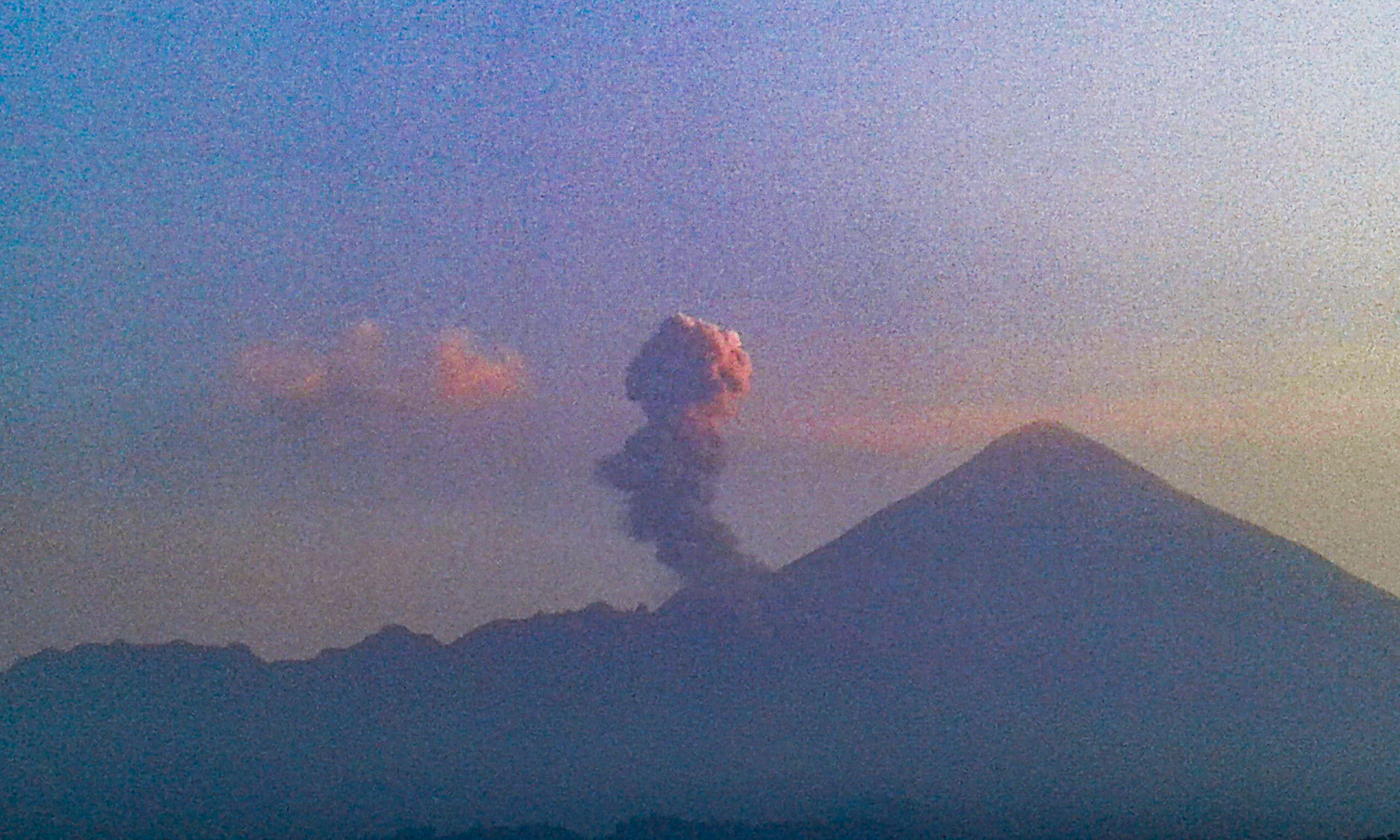 |
Figure 108. Image of an ash plume rising from the Caliente cone at Santa María during April 2020. Image has been color enhanced. Courtesy of INSIVUMEH (Fotografías Recientes de Volcanes). |
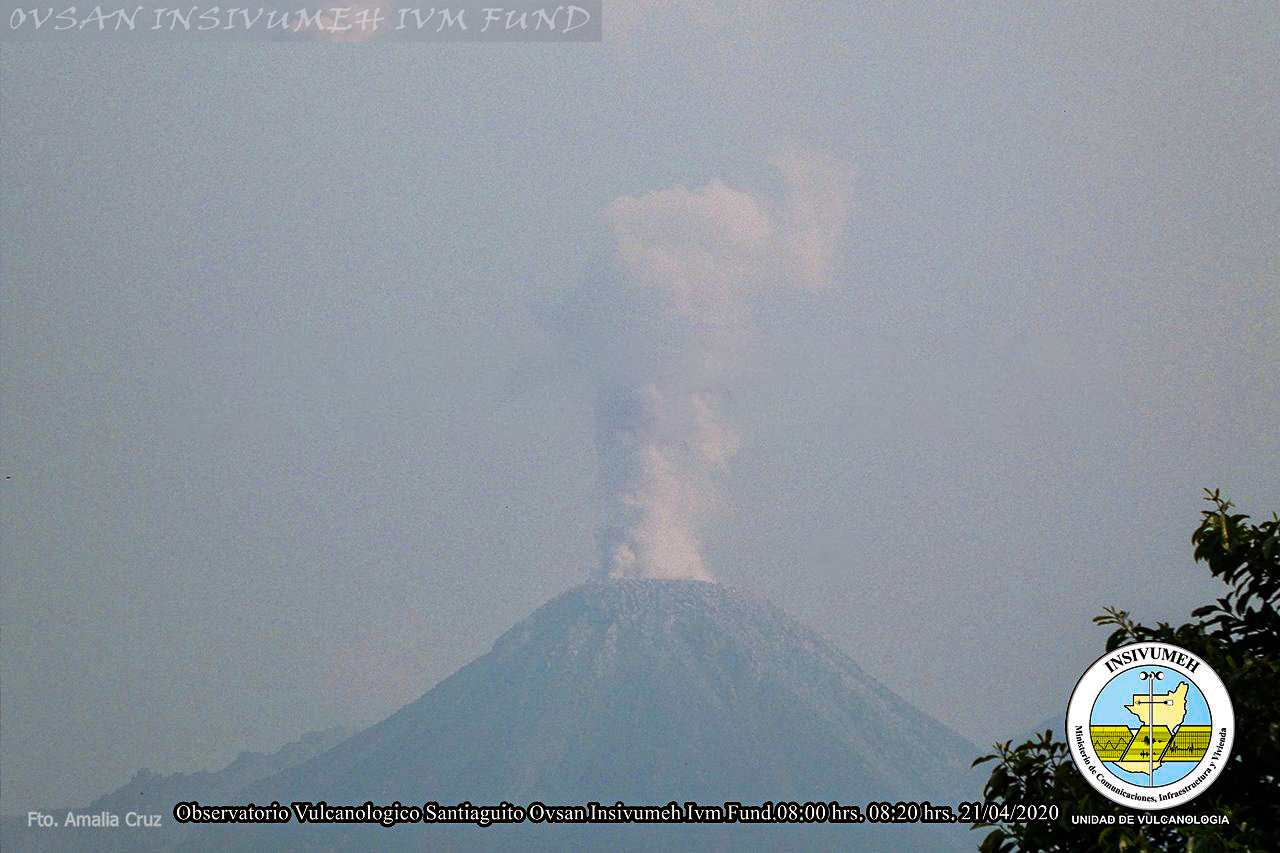 |
Figure 109. Webcam image of an ash plume rising from the Caliente cone at Santa María during 21 April 2020. Courtesy of INSIVUMEH (Fotografías Recientes de Volcanes). |
During May, continuous explosions produced ash plumes up to 3.5 km altitude drifting in multiple directions as far as 1 km from the Caliente dome. Constant weak and moderate block avalanches were observed on the S, SW, and SE flanks of the Caliente dome accompanied by some fine ashfall on the volcanic perimeter and white gas-and-steam emissions that rose 3.1 km altitude. On 7 and 17 May heavy rain on the upper part of the volcanic complex generated lahars that carried ash and blocks up to 1-2 m in diameter. Incandescence was intermittently observed at night.
Explosions from the Caliente dome in June were accompanied by ash plumes typically rising to 3.5 km altitude and drifting in different directions up to 1 km. Intermittent fine ashfall was reported around the volcanic; ashfall was also observed in the areas of Finca San José on 3 June, Loma Linda on 20 June, and Monte Carlo and surrounding areas on 22 June. Heavy rain on the upper part of the volcanic complex on 8 June generated lahars that carried ash and blocks up to 1-2 m in diameter. During the early morning on 9 June explosions produced an ash plume that rose to a maximum altitude of 3.7 km that drifted S and SW as far as 12-15 km from the Caliente dome. Weak and moderate pyroclastic flows and block avalanches on the S, SW, and SE flanks were also generated from these explosions. An explosion at 0535 on 19 June produced an ash plume that rose 3.5 km altitude and a small pyroclastic flow on the SW flank that reached the base of the Caliente dome. Incandescent pulses were visible at night and during the early morning on 19, 24, and 29 June. A Washington VAAC notice on 25 June reported a small ash plume drifting WNW, but it was not visible in satellite imagery. White gas-and-steam emissions continued rising to 3.4 km altitude while occasional incandescence was observed in the Caliente dome and on the S and SE flanks during the night and early morning.
Activity during July was similar to that of previous months. White gas-and-steam plumes continued to rise from the Caliente dome to 3.2 km altitude. STG3 seismic station registered weak to moderate explosions produced ash plumes up to 3.5 km altitude, resulting in occasional fine ashfall on the volcanic perimeter, in the villages of San Marcos and Loma Linda, Palajunoj on 20 and 30 July, and over Palajunoj and Fca Patrocinio on 25 July. Moderate to strong block avalanches were detected on the S, SW, and SE flanks. Incandescence at night was observed on most nights and during the early morning in the Caliente dome; incandescent pulses were reported on 4 July, according to INSIVUMEH. On 10-11 July the STG3 seismic station registered weak and moderate explosions that produced ash plumes up to 3-3.4 km altitude drifting W up to 12 km from the Caliente dome. Small pyroclastic flows and block avalanches on the W and NW flanks accompanied the explosions, resulting in ashfall in the villages of San Marcos and Loma Linda Palajunoj (figure 110). On 21 July weak and moderate explosions produced ash plumes up to 3.4 km altitude, resulting in slight ashfall on the volcanic perimeter, and moderate to strong avalanches on the S, SW, and SE flanks, some of which were accompanied by pyroclastic flows. During 25-26 and 31 July moderate and strong block avalanches on the W, NW, S, SW, and SE flanks were accompanied by pyroclastic flows.
MIROVA (Middle InfraRed Observation of Volcanic Activity) analysis of MODIS satellite data detected frequent thermal anomalies during March to mid-April 2020; after May the frequency and power of these anomalies decreased, but continued through July (figure 111). Some of these thermal anomalies were observed in Sentinel-2 thermal satellite imagery, originating from the summit of the Caliente cone (figure 112).
Geological Summary. Symmetrical, forest-covered Santa María volcano is part of a chain of large stratovolcanoes that rise above the Pacific coastal plain of Guatemala. The sharp-topped, conical profile is cut on the SW flank by a 1.5-km-wide crater. The oval-shaped crater extends from just below the summit to the lower flank, and was formed during a catastrophic eruption in 1902. The renowned Plinian eruption of 1902 that devastated much of SW Guatemala followed a long repose period after construction of the large basaltic andesite stratovolcano. The massive dacitic Santiaguito lava-dome complex has been growing at the base of the 1902 crater since 1922. Compound dome growth at Santiaguito has occurred episodically from four vents, with activity progressing E towards the most recent, Caliente. Dome growth has been accompanied by almost continuous minor explosions, with periodic lava extrusion, larger explosions, pyroclastic flows, and lahars.
Information Contacts: Instituto Nacional de Sismologia, Vulcanologia, Meteorologia e Hydrologia (INSIVUMEH), Unit of Volcanology, Geologic Department of Investigation and Services, 7a Av. 14-57, Zona 13, Guatemala City, Guatemala (URL: http://www.insivumeh.gob.gt/ ); MIROVA (Middle InfraRed Observation of Volcanic Activity), a collaborative project between the Universities of Turin and Florence (Italy) supported by the Centre for Volcanic Risk of the Italian Civil Protection Department (URL: http://www.mirovaweb.it/); Sentinel Hub Playground (URL: https://www.sentinel-hub.com/explore/sentinel-playground); Washington Volcanic Ash Advisory Center (VAAC), Satellite Analysis Branch (SAB), NOAA/NESDIS OSPO, NOAA Science Center Room 401, 5200 Auth Rd, Camp Springs, MD 20746, USA (URL: www.ospo.noaa.gov/Products/atmosphere/vaac, archive at: http://www.ssd.noaa.gov/VAAC/archive.html).


